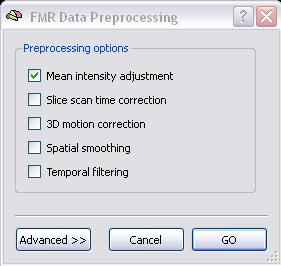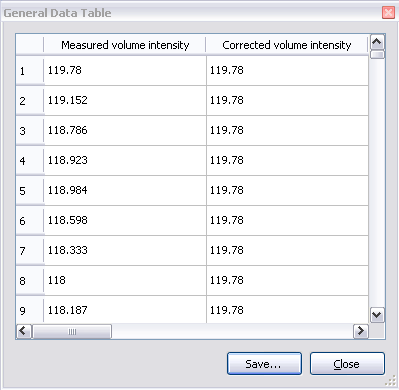Mean Intensity Adjustment
- Details
- Category: Pre-Processing
- Last Updated: 09 April 2018
- Published: 09 April 2018
- Hits: 3315
In the data of some scanners there might be global drifts over time, meaning that the signal level averaged across all voxels in the brain is characterized by substantial fluctuations.
The Release Notes of BrainVoyager QX 1.8 state the following about Mean Intensity Adjustment:
" Correction for global mean changes (from volume to volume) are usually not necessary.
In the data from some scanners, however, we observed, quite substantial fluctuations (e.g. ”spikes”), which should be removed during preprocessing (besides improving scanner performance). The previously existing ”Mean Intensity Adjustment” (MIA) option in the ”FMR Data Preprocessing” dialog could be used for this purpose, but this function worked at the slice level. This function has now been updated to work at the volume level. During operation, the program now plots two curves, one showing the measured mean intensity of volumes over time and the other showing the mean level of each volume after correction (a straight line).
Furthermore, a zero-mean predictor of the global fluctuations is automatically stored to disk allowing to add it as a confound predictor in the design matrix.
If the MIA preprocessed FMR is used for further processing (e.g., VTC creation), adding of the MIA confound predictor is not necessary. If one wants to perform the correction as part of the GLM, however, one should use the non-MIA FMR for further processing adding the MIA confound predictor to the design matrix."
This option is available via Analysis -> FMR Data Preprocessing -> Mean intensity adjustment.

In the plot below, the original mean intensity of each volume is depicted in red (first column in the table) and the corrected intensity in green (second column in the table).


After BrainVoyager has finished the computation 2 new files are automatically stored to disk: one preprocessed FMR characterized by the file name segment “_MIA” (together with the corresponding STC) and one SDM containing the zero-mean predictor of the global fluctuations.
There are two options to use the results of the mean intensity adjustment for further processing of the data: One can use the MIA processed FMR or one can perform the correction as part of the GLM by adding the MIA confound predictor to the design matrix.
However, this preprocessing option should be used with caution, since it might wrongly “correct” true condition effects. For instance, in an experiment for which in one condition increased widespread activations are expected while for another condition only small focal activations are expected, correcting for differences in the mean intensity of volumes would actually distort the effects of interest.
